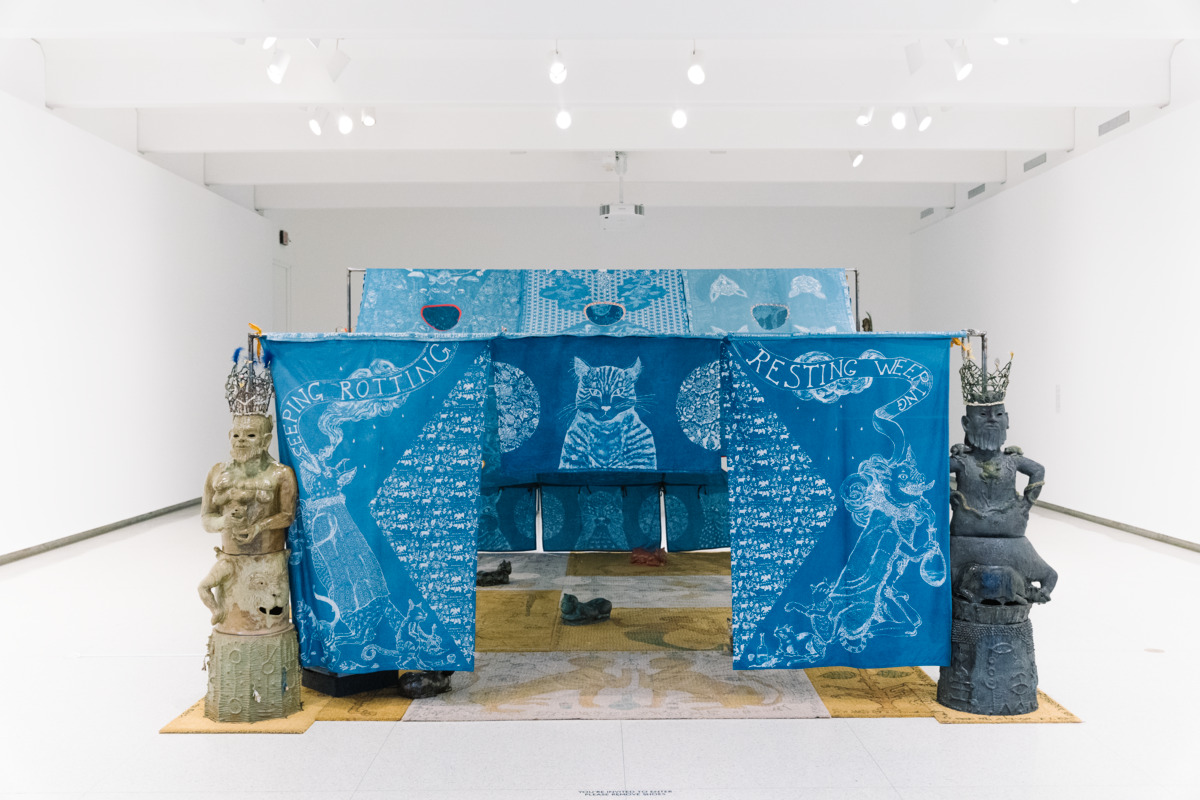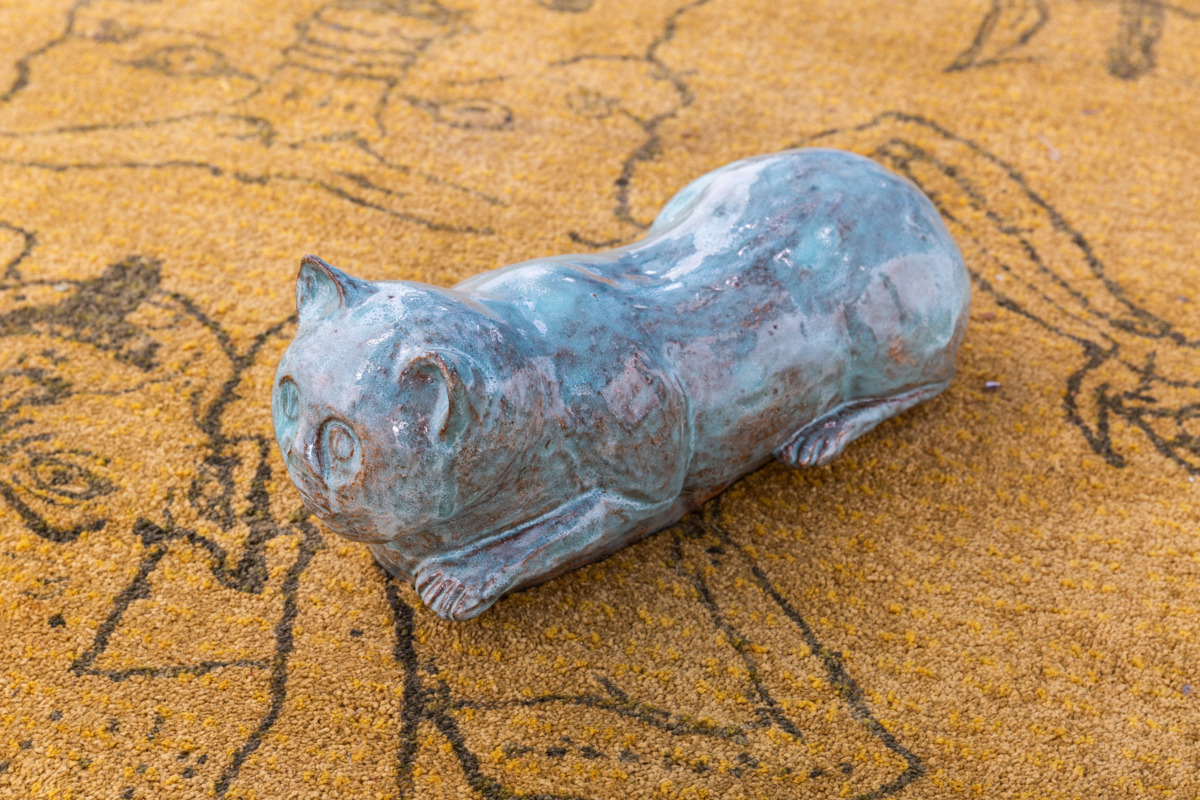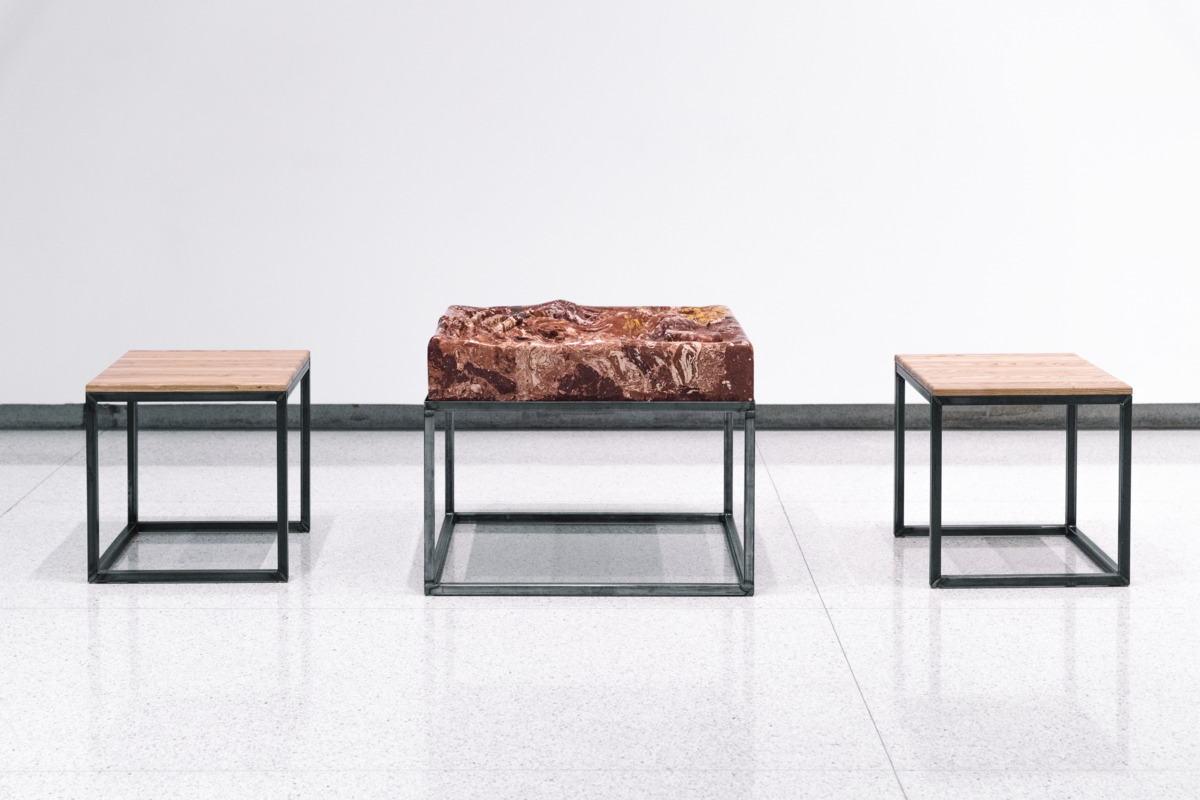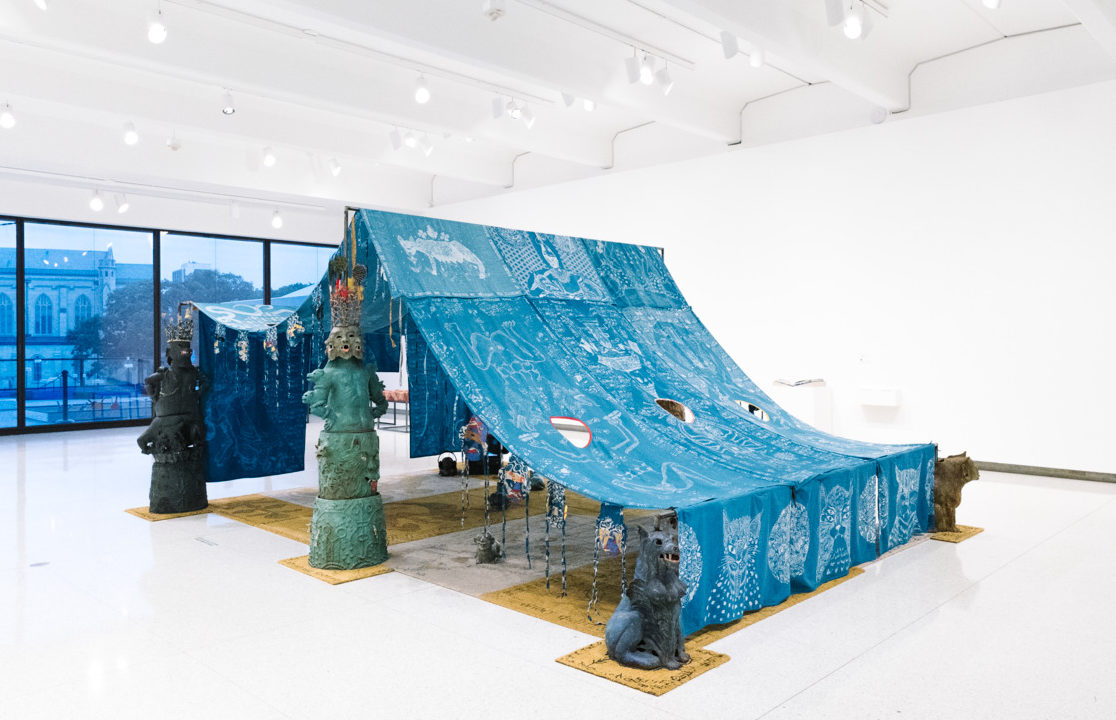Candice Lin: Seeping, Rotting, Resting, Weeping
Candice Lin, Seeping, Rotting, Resting, Weeping, installation detail, 2021 [photo: Ian Byers–Gamber; courtesy the artist and François Ghebaly, Los Angeles | New York]
Share:
*This piece will be published in our Winter 2021 issue, and is a sneak peek of what’s to come in volume 45.02
Scrawled in gray ink on an early page of A Journal of the Plague Year (Cat Demon Diary), Candice Lin tells of a cat named Mashim who ingests and regurgitates an indigo plant to create a portal into “the Blueness,” a netherworld inhabited by spirits and demons. On surrounding pages, colonial and material histories of indigo come in contact with pieces of the artist’s life—her cat; the strays on her porch; her studio practice; her fears, feelings, and vices—which together spill from the book, into the other objects that populate Seeping, Rotting, Resting, Weeping, her exhibition at the Walker Art Center [August 5, 2021–January 2, 2022]. In navigating the films, installations, objects, and texts on display, viewers are set adrift in specific references, untethered from origin, with only the Cat Demon Diary as a guide:
In many cultures, indigo has had ambiguous associations. In India for example, it is connected with both ill omen and with infinity …. The protective function of blue amulets has retained its potency in much of the Arab world, where various antidotes to death and illness, such as burning blue cloth and paper, have been recorded …. On the island of Sumba, according to Hoskins, a body of occult knowledge known as moro (Blueness) expounds indigo’s place in herbal medicines and secret rituals, including witchcraft …. In Liberia, a tale is told of the way post-menopausal women gained from the high god the secret of blue dyeing with indigo thanks to a seeress who broke off a piece of blue sky to eat.
Dyed indigo draperies hang from steel bars held up by many-faced—and many-breasted—ceramic figures inspired, as a wall label text informs me, by ancient Zhenmushou tomb guardians from the Tang Dynasty. As I sat on the dyed carpet, under the indigo fabric ceiling of this eponymous installation at the exhibition’s center, my eyes wandered over the blue and white mythological, psychedelic, and sexual imagery—some of which, though not all, indexed to the history of indigo. Lin studied and practiced traditional Japanese techniques of indigo printing, and also found inspiration in Nigerian adire cloths from the early 20th century. Through didactic texts and passages in the Cat Demon Diary, Lin reveals fragments of her expansive research, but most remains hidden behind a veil of aesthetic transformation.
Candice Lin, Seeping, Rotting, Resting, Weeping, installation view, 2021 [photo: Ian Byers–Gamber; courtesy the artist and François Ghebaly, Los Angeles | New York]
The tent-temple is repeated digitally in Millifree Work WearyTM Free Video, wherein an animated 3-D scan of a ceramic sculpture of a cat named White-and-Gray leads a Qigong meditation. Listening to the cat’s deepened voice, I couldn’t help but become more conscious of my posture, straightening my spine and breathing deeper for a moment. “Relaxation and moving through the center is key to Qigong,” the ceramic cat animation says. But my relaxation was ruptured by a new character entering in green text. Gascon, an autonomous bot, seeks to capitalize upon our engagement, our movement, our relaxation, spamming us with “free offers,” pop-up videos, advertisements, and memes. Recalling 19th-century Orientalist paintings depicting false realities that fetishized the people of West Asia and North Africa, and that functioned as propaganda for French imperialism in Egypt and Syria, the bot declares, “TikTok is our competitor. We are genuine.” Such a statement signals the new Orientalism of advertisers, influencers, and the digital wellness industry.
All these names such as damask or muslin carry with them a tremor. Exotic yet familiar, they stress the English speaking tongue in unusual ways. Stripped of their history, no less of their place-reference such as Damascus in Syria or Mosul in Iraq, they have become naught but names, less than names, really, just sounds, we might say: Yet for all that, and because of that, something hovers in the vague area that the sound can, on occasion, provoke.
This tension among image, myth, and history defines the exhibition. Here, image is akin to sound, carrying and conveying a vague sensation that indirectly links visual experience to history. Lin’s depictions—four-eyed cats, anthropomorphic animals, potions, swords, gods, demons, and an expansive symbology—feel of the past and yet out of time, as if collected by an errant traveler skipping across and between centuries and landscapes. Dogs with human heads, human bodies with bestial appendages, hares decapitating a naked man, men suckling at the breasts of a massive cat—this entanglement of bodies ruptures humanity’s self-constructed hierarchy, joining the chaos of references in the Blueness.
Candice Lin, Seeping, Rotting, Resting, Weeping, installation detail, 2021 [photo: Ian Byers–Gamber; courtesy the artist and François Ghebaly, Los Angeles | New York]
Candice Lin, Seeping, Rotting, Resting, Weeping, installation detail, 2021 [photo: Ian Byers–Gamber; courtesy the artist and François Ghebaly, Los Angeles | New York]
Lin could have chosen to display her sculptures and draperies more conventionally on plinths or hanging against the wall, and the show would have been stunning. But choosing to assemble her art objects as a provisional temple to the netherworld of Blueness is itself a poetic resistance to the hierarchy of history and knowledge often perpetuated by the white cube of a museum. We experience these objects differently because we see them while lying, sitting, crawling, standing, and touching. Separating art from the experience of our bodies is itself a colonial adaptation. We enter the works and, in turn, the works enter us, dragging with them the ghosts of history.
This entanglement between body and artwork puts special emphasis on the moments when Lin connects us to the present: flooding fueled by climate change, the January 6 coup attempt, a protest where activists carry signs that read “END WHITE SUPREMACY” and “NO JUSTICE NO PEACE ABOLISH THE POLICE.” “REDISTRIBUTE FUNDS” and “ABOLISH POLICE” also hide in the patterning of her indigo drapery—statements that feel particularly poignant, given that Minneapolitans will vote on dismantling and replacing their police department before this text is published.
Not just color but a way of being.
Candice Lin, Seeping, Rotting, Resting, Weeping, installation view, 2021 [photo: Ian Byers–Gamber; courtesy the artist and François Ghebaly, Los Angeles | New York]
In Poetics of Relation, Édouard Glissant writes, “The sacred is of us, of this network, of our wandering, our errantry.” I read Lin’s nether-world as other-world, the portal into the Blueness as a lens onto Otherness, extending Glissant’s method for reinterpreting and navigating our relation to history, to ourselves, to other people, places, and ecosystems. The Blueness becomes a way of being in the world that sanctifies the chaos of relation, of entanglement, of the openness of rhizomatic errantry.
Brooks Turner is an artist, writer, and educator. His work engages the history of fascism in Minnesota and has appeared at the Weisman Art Museum, St. Cloud State University, Soo Visual Arts Center, and Mn Artists. He is chair of visual art at Saint Paul Conservatory for Performing Artists and a lecturer at the University of Minnesota. He is the author of A Guide to Charles Ray Sleeping Mime, published with Paperleaf Press, as well as essays and reviews published by Hair and Nails gallery and ART PAPERS. Turner is currently a Minnesota Center for Book Arts/Jerome Foundation Book Arts Resident.



